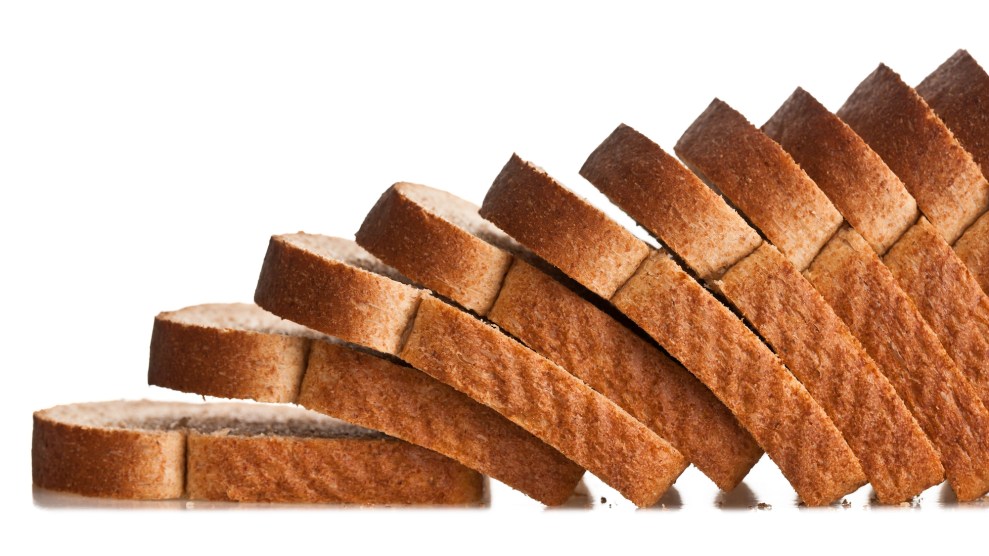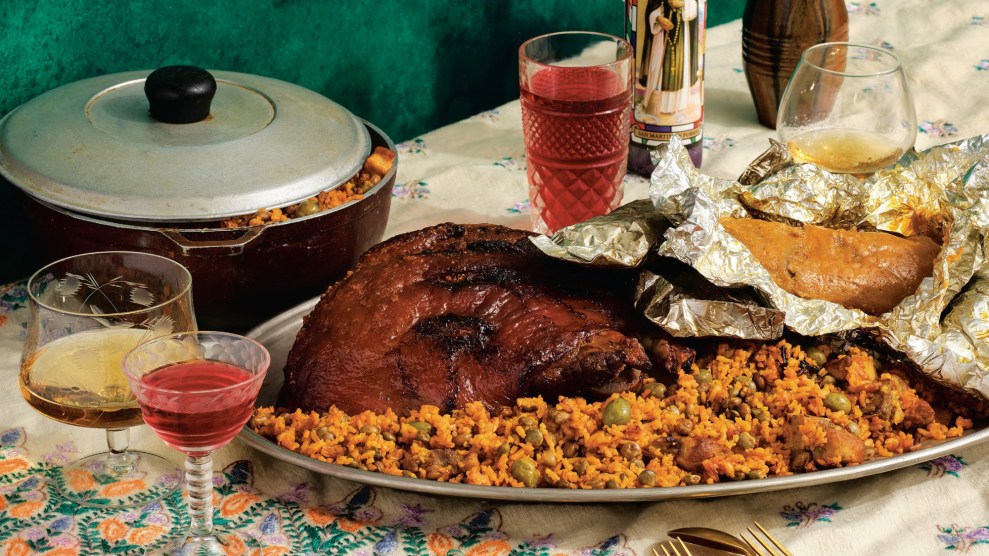
Perníl served over arroz con gandules.Dan Liberti/ Ten Speed Press
I’m in my elf pajamas, and one hand holds spiced coffee while the other unwraps my husband’s Christmas gift to me on this bright, bitter cold, bracing morning. It’s a copy of Diasporican: A Puerto Rican Cookbook, by Illyanna Maisonet, and naturally, I’m immediately offended. I have the punchiest sofrito in my family and my arroz con gandules is second only to my abuela’s. As far as I’m concerned, I know how to cook Puerto Rican food, and this book is an insult to the hours I’ve spent in the kitchen.
In moments, I realize that I am dreadfully wrong. My Grinch-y heart swells three sizes as I read stories that could be from my own life interwoven through the pages of Maisonet’s ninety-odd recipes. We are both Diasporicans: children, grandchildren, and descendants of Borinquen, the land renamed Puerto Rico by the Spanish.
Diasporican isn’t a manual for traditional Puerto Rican cooking. It’s for the “tribe of Ní De Aquí, Ne Allá [not from here, not from there],” as Maisonet puts it. It has traditional staples like mofongo and tostones alongside fusions like Puerto Rican laab and Cali-rican dishes unique to the Sacramento kitchen of Maisonet’s mother and grandmother. Its straightforward recipes are buttressed by the personal stories, essays, and deeply reported histories of the island and its food that were the hallmarks of Maisonet’s San Francisco Chronicle food column, Cocina Boricua. (You may also recognize her as one of the architects behind the 2020 racial reckoning at Bon Appetit.)
If you aren’t Puerto Rican (or a resident of Orlando or the Bronx) you might be struggling to think of what Puerto Rican food is. It’s not widely available outside Puerto Rican communities. “Puerto Ricans don’t tend to be cerebral about their food but rather emotional,” writes Maisonet. “The truth is, Puerto Rican cuisine shares a lot in common with the cuisines of Hawai’i, Guam, and the Philippines—all places that got fucked by Spanish and United States colonialism.”
We are a people of colonialism, the second-largest Hispanic group in the mainland US. There are more of us there—about 5.5 million, including those who share Maisonet’s stateside heritage—than on the island (3.2 million—and yes, technically, Puerto Rico is an archipelago). Second-class citizenship status that allows for migration between Puerto Rico and the mainland has created a tradition of circular migration; a poor economy forces many to look for work on the mainland who return to be with family in their older years. Nearly four percent of the island’s population relocated to Florida and elsewhere after Hurricane Maria, while some Diasporicans are returning, citing gentrification in Latinx neighborhoods or the desire to be involved in civil society back home.
It can be challenging to understand the island’s people, let alone its food. Puerto Rico was one of the first “New World” colonies, invaded first by Spain with the 1493 arrival of the murderous Christopher Columbus, and then by the United States from 1898 to the present day. Columbus met the Taíno, who had stewarded Borinquen for thousands of years, establishing large villages based on the cultivation of cassava and corn. The ancestors of those Taíno had been inhabitants of South America, bringing flora and fauna with them that remain part of the island’s diet today.
What the Taíno had to offer was neither palatable nor profitable for Columbus, whose men brought their own food from Europe, raped Taíno women and took them as wives, and enslaved or killed the Taíno men.
The food is African and Spanish and Middle Eastern and South American and even Chinese. The people are like that, too: National Geographic’s Genographic Project estimated in 2014 that Puerto Ricans’ ancestry, on average, is 12 percent Native American (more than any other Caribbean country), 65 percent Western European or Mediterranean, and 20 percent sub-Saharan African. In no way does this imply that Puerto Rico is some type of post-racial paradise. Indigeneity should never be measured by any type of blood quantum, and statistics have often been used to erase Blackness in Puerto Ricans—you’ll often hear people say “I’m not Black, I’m Puerto Rican.” Despite that ancestry, 75 percent of islanders identified as white on the most recent census.
All of this to say that we, like a good pastelón, are layered and complicated.
“There’s not a single word that I could use to define Puerto Rican cuisine. If I were forced to pick one, I’d choose sofrito,” says Maisonet. It’s the “soul” that goes in everything while the dishes somehow remain unique. It’s a blend of tomatoes, garlic, yellow onion, any type of sweet green peppers (traditionally aji dulces, known as ajicitos, but most of us use whatever we can find), cilantro, and culantro (also known as recao), an herb with long serrated leaves that’s native to the Caribbean.
“Culantro is like cilantro’s cousin who comes to visit from the hood…more ‘punchy’, ‘vocal’,’spirited’…possibly wearing FUBU,” writes Maisonet. “Someone who did not come to play and who gives zero fucks. And yet, you’re still happy it showed up to the party because it has the charisma to bring everyone onto the dance floor.”
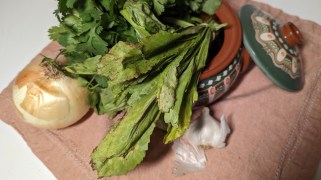
The violent history of colonialism comes straight to the table in the island’s national dish, one filled with flavor and celebration along with an undercurrent of trauma and grief. Arroz con gandules (rice with pigeon peas) is a daily staple of many Puerto Ricans’ diet. The Spanish brought rice thinking the Taíno would know how to cultivate it; they didn’t. Instead, they got sick from Spanish diseases and died. It was enslaved Africans, brought to work the sugarcane plantations, who made the rice crops—a West African staple—flourish. Maisonet points out that the recao in the sofrito is Taíno, the pork is Spanish, and the pigeon peas are from Africa. “Violence has always been present in my culture,” writes Maisonet. “From the decimation of most of our Taíno ancestors to the loss of more than four thousand of our gente in the aftermath of Hurricane Maria, violence is always there.”
My abuela came to New York from the rural Puerto Rican community of Isabela in the 1950s. She was part of a mass exodus known as the Great Migration, in which the federal and Puerto Rican governments encouraged Boricuas to leave the island for manufacturing jobs on the mainland as part of a shift from agriculture to industry.
We never spoke Spanish in our household when I was growing up. My mother, though now fluent, still retains trauma from elementary teachers who tried to hold her back academically because she had a Spanish last name. My dad is a gringo. But food has been a constant cultural connection. I can recall empanadas and tostones (fried plantains) as after-school snacks, and sofrito showing up in places it didn’t belong, like spaghetti sauce or lasagna.
I’ve had co-workers turn up their noses when I heated pungent, garlicky foods in the shared microwave. While I’ve felt like an outsider at times like those, I realize that I consume this food from the position of a colonizer, too. While Hurricanes Maria and Fiona have severely disrupted food supply on the island, I have always been able to find my traditional foods.
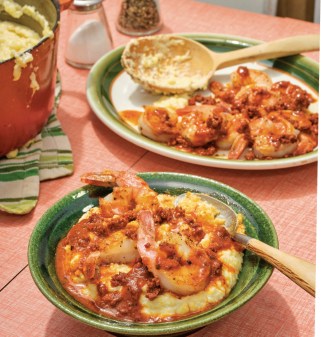
Likewise, my memories of shopping in Latin markets consist of bunches of cilantro, leafy greens, and succulent mangoes overflowing into the aisles. On the island, over 80 percent of food is imported. Puerto Rico is subject to the Jones Act, which requires all commercial trade between US ports to be done by ships that are US-built, registered, and crewed. That’s left the island almost entirely dependent on US shipping—and price gouging. “Most of the time, the food is not even good quality because it has lost its freshness during the long shipping to the island!” Maisonet explains in her book’s introduction. “Puerto Ricans’ pantries are basically in a perpetual state of survival mode. The pandemic pantry is a lot of folks’ everyday pantry.”
“Americanizing” food doesn’t always mean that we’re adapting our traditional recipes, although of course we do. Sometimes it means that we have the privilege of access.
The Colonizer’s Banana Leaf
If we pretend that time is indeed linear, and go back as near to the beginning as we can, we would encounter pasteles—most likely a pre-Columbian and seemingly the oldest known Puerto Rican dish. It’s intensely laborious, typically requiring many hands and certainly as many yards of counter space as you can muster. Similar in spirit to a Mexican tamale, it’s a log of masa (maize) dough filled with luscious pork all wrapped up and boiled to cook in banana leaves; rather than being maize-based, this masa is made from firm plantain, potato, guineos (green bananas), and white malanga (a tuber similar-ish to yucca). You’ll peel them all, with great difficulty; grate them (time consuming, painful); and if you happen to have any of those at the wrong stage of ripeness, your dish may well be ruined.
See what I mean by laborious? That doesn’t include the time you’ll spend stewing the meat, rolling out dough, and fumbling them into the banana leaves because you’re a gringa who didn’t realize cooking meant doing fucking origami. Even if you’ve got several hands on deck, you’re still looking at a minimum of five to six hours.
But once your mouth experiences that totally unique combination, the chewy sweetness of the masa meeting the rich, stewed meat, you’ll dream of it for the rest of your life. A word of warning: these aren’t really for the ‘gram. Depending on your guineos and plantains, pasteles come out a shade of dark orange to brown, and considering that they’re boiled rectangles, they look a bit like—well, caca.
My Titi Norma was a sorceress with pasteles—hers always came out just right—but my mom gave up after one very noble effort. Since my titi died, we’ve had to buy ours. But these aren’t the kind of things you can normally buy at a cuchifrito stand or even a restaurant. That’s not to say they’re never commercially available; I’ve seen them, but it’s not a common offering. My guess is that it’s too time-consuming and variable to be a reliable commercial product. You need to talk to a guy who knows a guy who has a cousin whose hairdresser’s brother will meet you in the Lowe’s parking lot to sell you pasteles by the dozen. True story.
In this recipe (and many others), I recognize Maisonet as a true Diasporicana sister, because she calls for wrapping the pastel in foil rather than banana leaves. “When you think of my grandma coming to Sacramento as a seventeen-year-old mother of two in 1956, you have to wonder, where the hell would she have found banana leaves in Northern California?!?” she asks. “She met the real test of preserving her heritage by giving a shit about adapting in an effort to see the legacy of her homeland’s food live on.”
Wrap them in foil, or in parchment paper, like we did in my house.
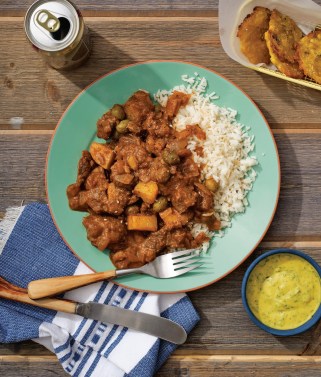
Pork: Monarch of Colonial Proteins
Do Puerto Ricans love pork, Maisonet asks, or is it “one of the few proteins that we are allowed under the strict government rules and guidelines?” Pork is a staple in Puerto Rican food, but Pigs aren’t native to Puerto Rico—they came with Columbus as early as 1512, a more desirable and profitable alternative for the Spaniards to crops grown by the Taino. The pigs “quickly adapted to the environment, became a source of food for the enslaved Taínos, and throughout history have been readily available through economic and demographic changes,” writes Maisonet. “And, possibly, they were also in demand after people developed a taste for their rich meat.”
In fact, that’s the history of most of the ingredients that make up Puerto Rican food today, as Maisonet so deftly explains. Coconuts, avocados, rice, plantains, and coffee are all foods that make up the backbone of the cuisine. None of them are native to the island. Like the people, they were brought from Africa or Central America because they were more profitable there or could elsewise serve colonization better.
Pernil is the best way to enjoy pork. Full stop. It is the best pork dish and I mean better than bacon. Time does the work for you in this recipe. Pernil is pork shoulder, and it isn’t pernil without the true pièce de résistance, the crispy rendered fat you’ll leave to crackle on top, seasoned with just a bit of salt, pepper, and oregano. “The skin glistened and was shatteringly crispy, you could hear it crackling from having all its fat rendered,” Maisonet writes of her abuela’s Christmas pork.
Take a knife to carve holes into the pork shoulder, deep as your finger, that you’ll fill with garlic cloves before you let the whole roast marinate overnight, uncovered. The next day, you’ll roast it for seven hours at low heat. I season mine a bit differently: I slather the meat in sofrito and squeeze a bit of lemon on it. Both work. In Maisonet’s family and many others, it’s served for Christmas. In Pennsylvania Dutch country, where I grew up, it’s traditional to eat pork and sauerkraut for good luck on New Year’s Day. For our family, that meant pernil and sauerkraut, because we are Diasporicans. It was the main course of my wedding feast. Pernil is special.
After trauma I find myself turning more to these foods of my childhood. Four years ago, as a junior reporter in Nome, Alaska, I took my first reporting trip to cover the death of an elder, a man who had fallen through the ice while subsistence fishing for his family. He had ice-fished in late October for years, but as the climate changed, the ice had gotten weaker, less predictable, and in a moment, he was gone. When I came back to the bustling 3,500-person metropolis of Nome, I scoured the grocery for anything bush Alaska could offer that might somehow pass for arroz con gandules. I came up with half-moldy cilantro purchased for six dollars a bunch, and cans of pinto beans rather than pigeon peas. As I stirred the pot, I couldn’t help but think of my Alaskan community—wracked by the pain of colonization as I cooked a dish born from the pain of colonization. That night, while the dishes soaked in the sink, I stepped outside to see the Northern Lights dance across the Arctic sky for the first time in my life. If that isn’t a sign from the ancestors, I’m not sure what else is.
In these pages, and at the stovetop, I find healing. This book is a triumph of Puerto Ricans and its Diasporicans—one that, as it celebrates our triumphs, doesn’t run away from our complexities and pain. Wherever we go, we will be resilient, creating something new while stretching and breathing life into the old. And we will be eating. We will be eating damn good. Buen provecho!
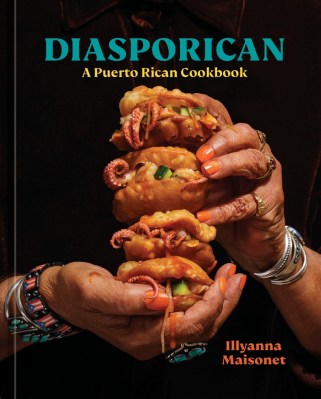
Carne Guisada
Makes four to six servings
I make this dish all the time, and yet I never tire of it. Sometimes I use pork, sometimes I use
chicken, and very infrequently, I use beef. The beef version is the most delicious, in my opinion,
but it’s also the richest. I use the same cut of beef when I make pot roast or beef stew; it’s a
tender cut that has a decent amount of fat. If you cut it into small chunks, it cooks quickly and
tenderly. This could easily become a part of your weeknight meal rotation.
Ingredients:
Two tablespoons canola oil or vegetable oil
1.5 pounds boneless chuck roast, cut into 1–inch chunks
One medium yellow onion, chopped
Two cups water, or as needed
Half cup tomato sauce
Half cup unpitted Manzanilla green olives (optional)
One large russet potato, peeled and diced
Quarter cup sofrito
One tablespoon sazón
Kosher salt
Freshly ground black pepper
Plain white rice for serving
Add the canola oil to a large heavy–bottomed pot and place over medium–high heat. Add the chuck roast and sear for three to five minutes, or until golden brown. Add the onion and cook for two to three minutes, or until translucent. Stir in the water, tomato sauce, half of the olives and potato pieces, two tablespoons of the sofrito, and the sazón. Scrape the bottom of the pot with a wooden spoon to loosen all the brown bits. Turn heat to low and let simmer, partially covered, for an hour, keeping an eye on it because the potato will thicken the broth and you might need to add more water.
Add the remaining half of the potato to the pot, season with salt and pepper, and cook for 15 to 20 minutes, or until the potato pieces are fork tender. Add the remaining 2 tablespoons sofrito and remaining olives and stir to distribute well.
Serve the guisada over rice.
Recipe reprinted with permission from Diasporican: A Puerto Rican Cookbook by Illyanna Maisonet. Published by Ten Speed Press, an imprint of Penguin Random House.
